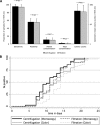Optimizing tuberculosis testing for basic laboratories
- PMID: 20889887
- PMCID: PMC2946764
- DOI: 10.4269/ajtmh.2010.09-0566
Optimizing tuberculosis testing for basic laboratories
Abstract
Optimal tuberculosis testing usually involves sputum centrifugation followed by broth culture. However, centrifuges are biohazardous and scarce in the resource-limited settings where most tuberculosis occurs. To optimize tuberculosis testing for these settings, centrifugation of 111 decontaminated sputum samples was compared with syringe-aspiration through polycarbonate membrane-filters that were then cultured in broth. To reduce the workload of repeated microscopic screening of broth cultures for tuberculosis growth, the colorimetric redox indicator 2,3-diphenyl-5-(2-thienyl) tetrazolium chloride was added to the broth, which enabled naked-eye detection of culture positivity. This combination of filtration and colorimetric growth-detection gave similar results to sputum centrifugation followed by culture microscopy regarding mean colony counts (43 versus 48; P = 0.6), contamination rates (0.9% versus 1.8%; P = 0.3), and sensitivity (94% versus 95%; P = 0.7), suggesting equivalency of the two methods. By obviating centrifugation and repeated microscopic screening of cultures, this approach may constitute a more appropriate technology for rapid and sensitive tuberculosis diagnosis in basic laboratories.
Figures


Similar articles
-
Tuberculosis diagnosis and multidrug resistance testing by direct sputum culture in selective broth without decontamination or centrifugation.J Clin Microbiol. 2008 Jul;46(7):2339-44. doi: 10.1128/JCM.02476-07. Epub 2008 Apr 30. J Clin Microbiol. 2008. PMID: 18448689 Free PMC article.
-
Increased sensitivity in diagnosis of tuberculosis in HIV-positive patients through the small-membrane-filter method of microscopy.J Clin Microbiol. 2013 Sep;51(9):2921-5. doi: 10.1128/JCM.00683-13. Epub 2013 Jun 26. J Clin Microbiol. 2013. PMID: 23804389 Free PMC article.
-
Rapid detection of Mycobacterium tuberculosis and rifampin resistance by use of on-demand, near-patient technology.J Clin Microbiol. 2010 Jan;48(1):229-37. doi: 10.1128/JCM.01463-09. Epub 2009 Oct 28. J Clin Microbiol. 2010. PMID: 19864480 Free PMC article.
-
[Advantages and drawbacks of expectoration decontamination methods for tuberculosis and anti-tuberculosis drug resistance diagnosis].Ann Biol Clin (Paris). 2013 May-Jun;71(3):283-91. doi: 10.1684/abc.2013.0815. Ann Biol Clin (Paris). 2013. PMID: 23747665 Review. French.
-
General and advanced diagnostic tools to detect Mycobacterium tuberculosis and their drug susceptibility: a review.Eur J Clin Microbiol Infect Dis. 2015 May;34(5):851-61. doi: 10.1007/s10096-014-2306-5. Epub 2015 Jan 6. Eur J Clin Microbiol Infect Dis. 2015. PMID: 25560709 Review.
Cited by
-
Evaluation of bleach-sedimentation for sterilising and concentrating Mycobacterium tuberculosis in sputum specimens.BMC Infect Dis. 2011 Oct 11;11:269. doi: 10.1186/1471-2334-11-269. BMC Infect Dis. 2011. PMID: 21985457 Free PMC article.
-
The Potential for Testing Stool to Reduce Tuberculosis Missed Diagnoses and Misdiagnoses.Am J Trop Med Hyg. 2018 Aug;99(2):243-245. doi: 10.4269/ajtmh.18-0507. Am J Trop Med Hyg. 2018. PMID: 30076698 Free PMC article. No abstract available.
-
Sputum Microscopy With Fluorescein Diacetate Predicts Tuberculosis Infectiousness.J Infect Dis. 2017 Sep 1;216(5):514-524. doi: 10.1093/infdis/jix229. J Infect Dis. 2017. PMID: 28510693 Free PMC article.
-
Clinical evaluation of tuberculosis viability microscopy for assessing treatment response.Clin Infect Dis. 2015 Apr 15;60(8):1186-95. doi: 10.1093/cid/ciu1153. Epub 2014 Dec 23. Clin Infect Dis. 2015. PMID: 25537870 Free PMC article.
-
A controlled evaluation of filter paper use during staining of sputum smears for tuberculosis microscopy.Wellcome Open Res. 2023 Apr 14;8:171. doi: 10.12688/wellcomeopenres.18827.1. eCollection 2023. Wellcome Open Res. 2023. PMID: 37766850 Free PMC article.
References
-
- Kent PT, Kubica GP. Public Health Mycobacteriology: A Guide for the Level III Laboratory. Atlanta, GA: Centers for Disease Control; 1985.
-
- Grandjean L, Martin L, Gilman RH, Valencia T, Herrera B, Quino W, Ramos E, Rivero M, Montoya R, Escombe AR, Coleman D, Mitchison D, Evans CA. Tuberculosis diagnosis and multidrug resistance testing by direct sputum culture in selective broth without decontamination or centrifugation. J Clin Microbiol. 2008;46:2339–2344. - PMC - PubMed
-
- Mueller DH, Mwenge L, Muyoyeta M, Muvwimi MW, Tembwe R, McNerney R, Godfrey-Faussett P, Ayles HM. Costs and cost-effectiveness of tuberculosis cultures using solid and liquid media in a developing country. Int J Tuberc Lung Dis. 2008;12:1196–1202. - PubMed
-
- Centers for Disease Control and Prevention . Biosafety in Microbiological and Biomedical Laboratories. Atlanta, GA: Centers for Disease Control and Prevention; 2007.
-
- Clark DE. Safety and the Laboratory Centrifuge. Washington, DC: Division of Chemical Health and Safety, American Chemical Society; 2001.
Publication types
MeSH terms
Substances
Grants and funding
LinkOut - more resources
Full Text Sources
Medical

